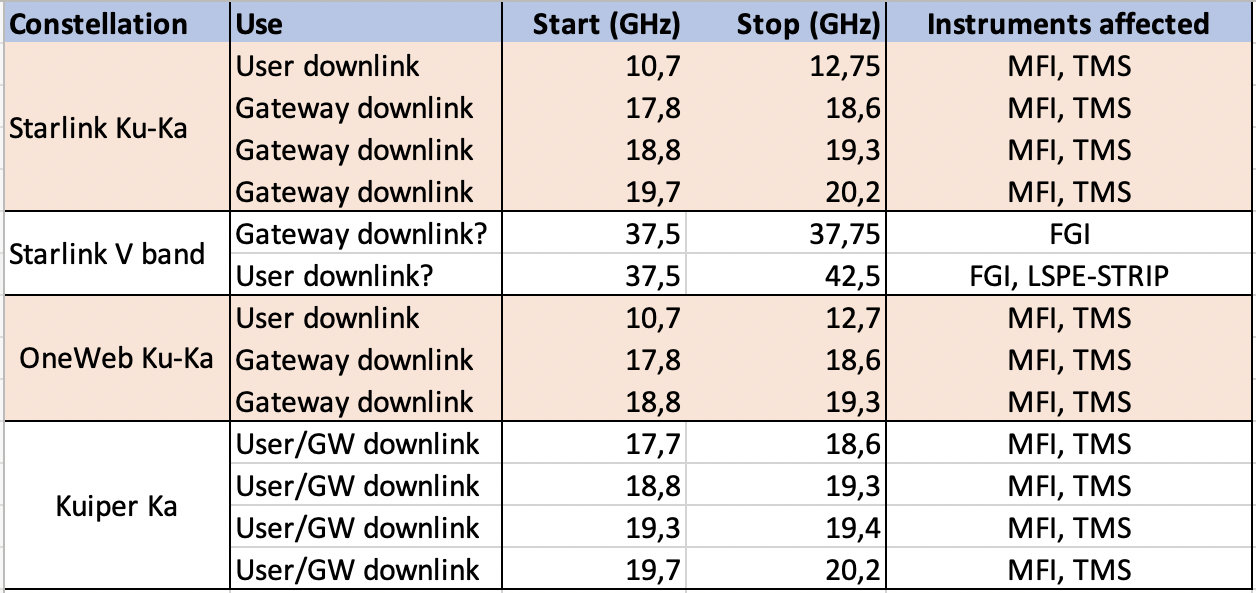News
Impact of Satellite “Mega constellations” on CMB experiments at the Teide Observatory |
| Posted by J Alberto Rubiño Martín (jalberto) on Oct 23 2020 |
The study of the Cosmic Microwave Background (CMB) anisotropies has played a key role in the last decades in transforming cosmology into a precision science and in establishing the standard model of Cosmology. In the coming years, new observations from multiple facilities, both ground-based and space missions, will provide key information about the inflationary era and the Standard Model of Particle Physics, including the neutrino sector.
Multiple ground-based observatories, including the Canary Islands, the Atacama desert and the South Pole, are now running, or will be operating during the next decade, a significant number of high-sensitive experiments, spanning the frequency range from 10 to 250 GHz.
In particular, from the Teide Observatory in Tenerife, the QUIJOTE CMB experiment is operating in the frequency range 10-40GHz, with three instruments: MFI (10-20 GHz), TGI (26-36 GHz) and FGI (36-46 GHz). Next year, the LSPE-STRIP experiment will observe in the 39-47 GHz band and, in two years from now, the Tenerife Microwave Spectrometer (TMS) will also observe in the 10-20 GHz band. Due to their scientific goals to observe large-scale emission on the sky, these experiments have angular resolutions around 1 degree. The high-sensitive continuum and polarisation measurements required by this type of experiments imply that broad-band observations are mandatory to fulfil their scientific goals. Frequencies around 15GHz are already impossible to observe due to geostationary satellite contamination and downlink communications.
Radio transmissions from satellite constellations will use several frequency ranges (see table 1 below for downlink sub-bands) in the middle of the range observed by the QUIJOTE and TMS experiments. In the past, the 10.7-12.7GHz band was already used by the satellite industry, but it was possible to conduct scientific observations due to the limited number of satellites and their fixed position in the sky (geo-stationary orbits). However, the deployment of the new Mega Constellations will change the situation dramatically, making the decontamination of these fast-moving objects almost impossible. This will significantly limit the accessible band, increasing in the same proportion the required integration times to achieve the scientific goals. This will happen even when satellites are not directly in the telescope beam, as these radio telescopes are sensitive to satellites transmitting in sidelobes of the main beam, even an experiment like QUIJOTE that has been designed to have minimal sidelobes.
One possibility raised during the Dark & Quiet Skies conference is to turn off Starlink transmitters as they pass over astronomical observatories. Due to the high altitude of the Teide Observatory, this will probably require turning them off whenever they are near the Canary Islands as a whole, not just when they are over the observatory. It will be possible to partially mitigate some of the contamination from the satellites by using digital back-ends, which QUIJOTE MFI plans to do soon, but at the expense of significantly increasing the cost of the project. However, the loss of bandwidth available will impact the science return of the projects in the planned timescales.

Table 1. The satellite transmission frequencies that will affect the QUIJOTE instruments, TMS and LSPE-STRIP. Only satellite downlinks are included, as we assume no user uplinks will take place near the Teide Observatory.
Last changed: Jun 09 2021 at 12:12 PM
Back